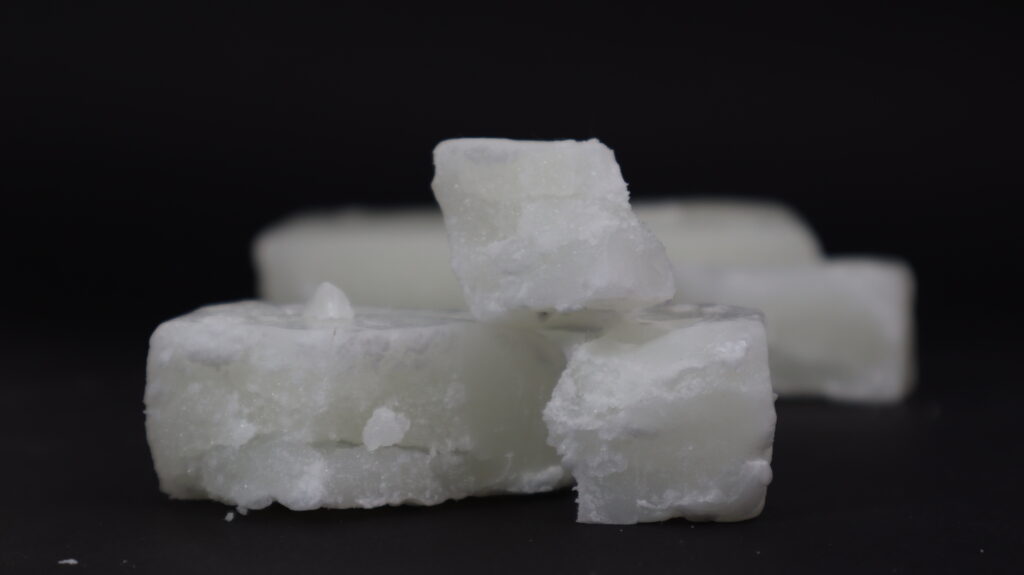
Paraffin Wax:
Paraffin wax is a solid, crystalline material that is soft, white, and typically colorless at room temperature. It is derived as a byproduct of the oil refining process, specifically from gasoil or kerosene obtained during distillation in refineries.
With a melting point ranging from 40°C to 70°C, the physical properties of paraffin wax are influenced by factors such as the length of the hydrocarbon chain, the composition of aromatic components, and the extent of branching.
Characterized by a density of 900 kg/m3, paraffin wax is composed of a mixture of hydrocarbon molecules containing 20 to 40 carbon atoms. Its general formula is (CnH2n+2).
Origin of Paraffin Wax
Paraffin wax was discovered in 1830 by German chemist Karl Reichenbach. It was initially produced through the process of cracking mineral oil.
Types of Paraffin Wax There are two types of paraffin wax:
- Fully refined paraffin wax:
This type of paraffin wax has a lower oil content compared to semi-refined paraffin wax. It is water-free, odorless, and has a solid structure that is resistant to easy changes. - Semi-refined paraffin wax:
Semi-refined paraffin wax has a higher oil content than fully refined wax.
Applications of Paraffin Wax
Paraffin wax finds a wide range of applications in various industries, including:
- Candle making:
Paraffin wax is commonly used in candle production, including warmers and different types of candles. - Paint making:
It is used in the production of ink for thermal printers. - Thermal and electrical insulation:
Paraffin wax is utilized in electrical products like transformers and inductors, providing insulation and moisture protection. - Waterproof coatings:
Paraffin wax is used to coat and preserve fruits, vegetables, chocolate, and cheese, extending their shelf life. - Building materials:
It is incorporated into building materials such as drywall and PVC pipes to prevent corrosion. - Medical:
Paraffin wax is employed in histology and pathology laboratories for tissue preservation and as a coating for tablets and capsules. - Lubrication:
It serves as a lubricant for machine parts, bicycles, engine chains, and various lubricating purposes. - Other uses: Paraffin wax has additional applications in matchmaking, paper coating, rubber making, glue production, cosmetics, and hygiene products.
Advantages of Paraffin Wax
Paraffin wax offers several advantages, including:
- High thermal stability: Paraffin wax exhibits high thermal stability, making it suitable for heat storage applications due to its high specific heat capacity.
- Water resistance: Paraffin wax has good resistance against water, making it useful for applications requiring protection against moisture.
- Low water vapor permeability: Paraffin wax has low water vapor permeability, further enhancing its water resistance properties and making it effective as a barrier against moisture.
- Electrical insulation: The relatively good dielectric strength of paraffin wax allows for its use as an insulation material in electrical appliances.
Overall, the high thermal stability, water resistance, low water vapor permeability, and electrical insulation properties of paraffin wax contribute to its versatility and suitability for various applications.
Paraffin Wax Testing
To determine the properties of paraffin wax, various tests can be conducted using internationally recognized standard test methods, such as those specified by ASTM (American Society for Testing and Materials). These tests help assess the quality and characteristics of paraffin wax.
Melting Point Test (ASTM D87)
The melting point test, conducted according to ASTM D87, is used to determine the temperature at which solid paraffin wax transitions into a liquid state.
The melting point of paraffin wax is influenced by its molecular weight, with higher molecular weights corresponding to higher melting points.
During the test, the paraffin wax sample is heated until it completely melts. The liquid wax is then transferred to a test tube equipped with a thermometer and placed in an air bath.
The temperature is recorded at regular intervals as the liquid paraffin wax cools and solidifies.
The melting point obtained through the ASTM D87 test method is often used to determine the type and quality of paraffin wax.
Flash Point Test (ASTM D92)
The flash point test, performed according to ASTM D92, is used to determine the temperature at which paraffin wax can ignite and sustain a flame.
During the test, a sample of paraffin wax is placed in a cup. The temperature of the cup is gradually increased, initially at a rapid rate and then more slowly.
A flame is then passed over the top of the cup. The lowest temperature at which the paraffin wax vapors ignite and sustain a flame for a brief moment is recorded as the flash point of the wax.
The flash point obtained through the ASTM D92 test method provides valuable information about the potential fire hazard and safety considerations associated with handling and storing paraffin wax.
Congealing Point Test (ASTM D938)
The congealing point test, conducted according to ASTM D938, is used to determine the temperature at which paraffin wax solidifies and no longer flows. This test can provide insight into the purity and quality of the paraffin wax.
During the test, a thermometer is immersed in the paraffin wax sample. The thermometer, along with the covered paraffin wax, is then slowly rotated in the air. The congealing point is the temperature at which the paraffin wax freezes and solidifies.
By measuring the congealing point, the characteristics and performance of the paraffin wax can be assessed, including its ability to maintain its solid state under specific temperature conditions.
Congealing Point Test (ASTM D938)
The congealing point test, conducted according to ASTM D938, is used to determine the temperature at which paraffin wax solidifies and no longer flows. This test can provide insight into the purity and quality of the paraffin wax.
During the test, a thermometer is immersed in the paraffin wax sample. The thermometer, along with the covered paraffin wax, is then slowly rotated in the air. The congealing point is the temperature at which the paraffin wax freezes and solidifies.
By measuring the congealing point, the characteristics and performance of the paraffin wax can be assessed, including its ability to maintain its solid state under specific temperature conditions.
Penetration Test (ASTM D1321)
The penetration test, conducted in accordance with ASTM D1321, is used to measure the hardness or consistency of paraffin wax.
In this test, a sample of paraffin wax is heated to a specified temperature and then allowed to cool. The cooled sample is placed beneath a penetrometer needle. The depth to which the needle penetrates the wax, measured in tenths of millimeters, is recorded as the test value.
The penetration test provides an indication of the hardness or softness of the paraffin wax, which can help determine its suitability for specific applications and desired properties.
Viscosity Test (ASTM D445)
The viscosity test, conducted following ASTM D445, is used to determine the kinematic viscosity of paraffin wax, which provides information about its flow behavior.
During the test, liquid paraffin wax is allowed to flow at a constant volume through a capillary. The time taken for the flow is recorded. This time is then multiplied by the calibration factor to obtain the viscosity of the paraffin wax.
Density Test (ASTM D1298)
The density test, performed according to ASTM D1298, determines the density or specific gravity of paraffin wax, which is important for storage and handling considerations.
In this test, the temperature of the paraffin wax is brought to a specific temperature. A suitable hydrometer is immersed in the sample, allowing it to settle. After reaching temperature equilibrium, the scale reading of the hydrometer and the sample temperature are recorded to calculate density or specific gravity.
Odor Test (ASTM D1833)
The odor test, conducted as per ASTM D1833, assesses the odor intensity of paraffin wax, especially relevant for applications in cosmetics and food packaging.
In this test, a 10-gram sample of shaved paraffin wax is placed in an odorless glass bottle with the lid closed. After 15 minutes, the sample is evaluated in an odorless room by gently removing the cap. Each person taking the test assigns a score ranging from 0 (no odor) to 4 (very strong odor). The reported value is the average score given by the group members.
Color Test (ASTM D156)
The color test, conducted according to ASTM D156, is used to assess the color of paraffin wax, which can indicate the degree of refinement and potential contamination.
The test apparatus consists of a light source, two glass tubes (one for the sample and the other for testing), and a heater.
During the test, a sample of paraffin wax is placed in a graduated glass tube and heated. The color of the sample is compared with standard color discs. If the sample’s color is darker than the color on the disc, the valve is opened to reduce the amount of sample, making its color lighter.
The height of the graduated column is measured, and the corresponding color is recorded. The sample’s color number is determined by selecting the standard color disc with a number higher than the obtained color.
It’s important to note that while the color test provides a qualitative indication of the paraffin wax’s color and potential contamination, it is not considered a highly accurate indicator of product quality.
Paraffin Wax Storage Guidelines To ensure the quality and longevity of paraffin wax, it is important to follow proper storage practices.
Here are some guidelines:
- Temperature: Store paraffin wax at a temperature below 40°C (104°F). Avoid exposure to high temperatures as repeated melting and freezing can alter its physical properties.
- Container: Store paraffin wax in a closed container to prevent contamination and minimize oxidation.
- Oxidation: Improper storage can lead to oxidation, which negatively affects the performance and lifespan of paraffin wax. Take precautions to minimize exposure to air and moisture.
- Tank Materials: Avoid using tanks or containers made of copper, brass, or their alloys for storing or transferring paraffin wax. These materials can catalyze oxidative reactions in the wax.
- Fire and Electrical Safety: Keep storage tanks away from open flames and sources of ignition, as paraffin wax is flammable. Additionally, prevent contact with open electrical coils to reduce the risk of fire hazards.
By following these storage guidelines, you can help maintain the quality and performance of paraffin wax over time.
Paraffin Wax Handling Guidelines
When handling paraffin wax, it is important to observe the following points:
- Respiratory Protection: When working with molten or hot paraffin wax, use appropriate respiratory protection to avoid inhaling fumes or vapors.
- Skin Contact: Avoid direct contact with molten paraffin wax as it can cause burns. Use protective gloves or other suitable barriers to prevent skin exposure.
- Static Electricity: Be aware that in its liquid state, paraffin wax can accumulate static electricity, especially in large quantities. This static electricity can potentially lead to sparks and combustion. Take necessary precautions to minimize static build-up, such as using proper grounding techniques and avoiding frictional contact.
By adhering to these handling guidelines, you can ensure personal safety and minimize potential risks associated with working with paraffin wax.
Effects of Long-Term Exposure to Paraffin Wax on Health
While paraffin wax generally does not pose immediate dangers in short-term exposure, prolonged and repeated exposure can have adverse effects on human health, including:
- Inhalation: Prolonged inhalation of aerosolized paraffin wax particles can lead to lung damage over time. It is important to minimize exposure to airborne paraffin wax particles, especially in industrial settings where aerosolization may occur.
- Ingestion: Significant oral consumption of paraffin wax can result in intestinal obstruction in humans. It is essential to prevent accidental ingestion or intentional consumption of paraffin wax.
- Skin Problems: Extended contact with paraffin wax, particularly in sensitive individuals, may lead to skin issues such as chronic dermatitis (inflammation of the skin) and the development of papules (small raised skin bumps).
To mitigate these health risks, it is advisable to follow proper safety measures, including using appropriate personal protective equipment, maintaining good hygiene practices, and minimizing direct and prolonged exposure to paraffin wax.
